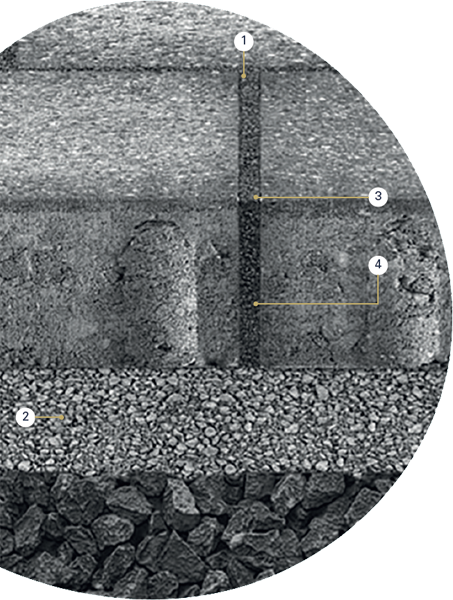PAVER SYSTEM
ECOSAVE PROTECT
For heavily used traffic areas DTV > 15,000.
For moderately loaded traffic areas.
For lightly used traffic areas.
PLANNING CERTAINTY THROUGH APPROVALS
DIBT
APPROVAL
TENDER SPECIFICATIONS &
DRAWINGS
Request your
tender texts and
drawings!
PLANNING TOOLS
Individual, needs-oriented &
up-to-date information
BIM DATA
Building information modeling
(Building Information Modelling, BIM) for
the provision of 3D and 2D data,
tender texts and other
information for your construction projects.
YOU NEED PROFESSIONAL
SUPPORT OR
HAVE QUESTIONS FOR US?

Jonas Bitterling, M. Eng.
Project Engineer
Tel +49 (0) 7334 92460-12
Mail bitterling@3ptechnik.de

Daniel Betschner,
Master Professional of
Technical Management (CCI)
Project Engineer
Tel +49 (0) 7334 92460-32
Mail betschner@3ptechnik.de
FUNCTIONAL PRINCIPLE

①
The rainwater passes through the joints into the porous core concrete
②
When this reservoir is completely full, excess water seeps away via the bedding
③
Rainwater runoff is cleaned in the joints and in the concrete
④
After the rain event, the stored water evaporates into the atmosphere via the joint
ECOSAVE PROTECT
BETTER FOR THE WATER BALANCE
Water-permeable paving from the ECOSAVE protect range has DIBt approval as a rainwater treatment system.
This means that the tested systems are able to filter, convert and/or break down ecologically risky pollutants so that our waters, including groundwater, are protected. The coverings are therefore also permitted for traffic areas where conventional eco-pavers are currently taboo.
The traffic areas in question here are, for example, residential roads, car and truck parking lots or yard and commercial areas with more than 300 vehicle movements per day. These areas have to be surfaced for traffic use anyway. With ECOSAVE protect, it is now possible to treat rainwater in these sensitive areas in a decentralized manner, i.e. simply allow it to seep away.
The rainwater enters the subsoil via the joints or porous concrete blocks. When new, the permeability of the systems must be more than 540 l/(sxha), far more than any rainwater or combined sewer can absorb. The pollutants are primarily collected in the top two centimetres of the joint material. Over time, the infiltration capacity decreases. After around 10 to 15 years, the pavements must therefore be regenerated using a suitable cleaning process. This involves removing and disposing of a large proportion of the pollutants. The top two centimetres of the joint are repointed.
A special hydride stone can do even more. It stores the rainwater in a storage layer with multiple spores. The facing of the concrete block is impermeable and the water only penetrates the concrete block through the joints. Up to 10 mm of precipitation is temporarily stored and released back into the atmosphere after the rain event. Only excess water is allowed to seep away. This allows evaporation rates of up to 50 % to be achieved over the year. The green area for road traffic.
FILTER VARIANTS
Substrate filter channel
For heavily loaded
traffic areas
Water-permeable surface covering with cleaning function.
Permanent infiltration capacity > 270 l/(s-ha).
Discharge coefficient 0.0 possible.
Cross slope of roads and parking lots only 1%.
Flexible design with all possible surfaces.
Many formats possible.
Joint width meets DIN requirements.
Construction compliant with regulations.
Annual evaporation of up to 50 % possible.
